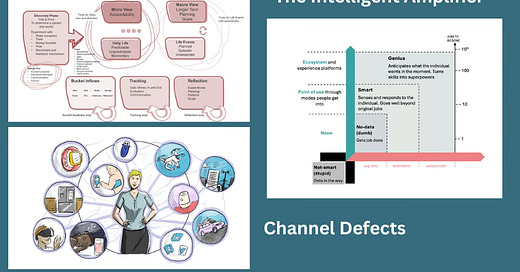The Difference between the Innovator and the Experience Strategist
Chapter Four: Principle 3—Customers need the Whole Job to Get Done
Dear Friends,
Today’s post is the last—for now—in chapter 4. I hope you will agree that the ‘whole’ JTBD is not the same as the ‘big’ JTBD. I’ve tried to address the topic from multiple angles. Nor is the experience strategists the same as the innovator. Of course, there is some overlap, but the innovation role is distinct from the experience strategist.
Please share this post with three people!
The Difference between the Innovator and the Experience Strategist
The Innovator Focuses on the JTBD, The Experience Strategist Focuses on the Whole JTBD
There is a difference between the innovator and the experience strategist. The roles are not the same. Though there is overlap and the two can work together well, the differences are important to understand and to embrace.
I remember well working with a large company that was standing up an innovation team at the same time that it was trying to develop a core competency in experience strategy. The innovation team, which was led by a competent guy, started by surveying the leaders of different business units about their challenges. His first goal was to create incremental improvements to the current business model. Once he was able to identify a list of things to work on, he could begin the next initiative: standing up a process for vetting and creating big innovations.
There was real, hard work to be done by his team. He needed to create a stage gate process, a prioritization process, and a methodology for solution development. He did not want a waterfall approach—where all innovations were dependent on one masterplan. He wanted to be as agile as possible, yet coordinated so that new innovations built on older ones.
It takes a lot to create incremental innovation in large companies.
He and his team understood JTBD theory. He asked me to teach the entire leadership team about jobs to be done and facilitate workshops on jobs to be done, which was productive. But his starting place was not the same as mine.
An innovation team needs to focus on the job to be done for the challenge they’ve been given. Sometimes that challenge is business transforming. But most of the time the innovations are incremental. In all cases they need to focus on the task, moment, or issue at hand. Most of the time they will apply their understanding of JTBD to the specific innovation they are working on.
The same holds true for the UX team, the CX people, the designer, or whoever else is called upon to improve aspects of the experience. When given a challenge to solve for, we solve for the issues at hand.
The experience strategist has an additional responsibility. It is to look across the entire business model, the company’s assets, and especially its tools and channels to determine whether or not the whole job is being done. And to make recommendations when gaps are found.
As I wrap up this chapter, let me state again that I do not think there is one definition for what the whole job means. I have shared four lenses for companies to view the challenge through. They are:
The Taxonomy – Types of JTBDs have delivery experiential requirements
The Customer’s System – Your solution fits within a customer’s system
Intelligent Amplifier – The more intelligent the solution, the more jobs the customer wants the solution to do
Channel Defects – If they can’t finish the job, why do you need the channel?
There are likely other lenses that smart strategists will develop. The experience strategist must look across the business model and determine where the customer’s needs are not being fulfilled.
The New Strategy Skill: Whole Job Planner
This skill of looking across the business model and identifying opportunities to get the whole job done is new, though elements of the skill have been done by leaders for some time. It grows out of the complexity of most modern business models. It addresses the fast changing landscape of technology. And it keeps the focus on the customer. When I think about this role, I imagine someone who can do the following:
Provide a holistic understanding of the jobs to be done from the customer’s point of view
Recommend the most effective way to get the whole job done. Should the company outsource, partner, build within, play a role, or involve the customer?
Recommend changes to channels and tools that will improve the whole job strategy
Recommend channel elimination as new technologies get more of the whole job done for the customer
Work with the innovation team to prioritize solutions
Keep a big picture view of what the company can and should be doing
Reflection Activity
Reflect for a few minutes about the differences between JTBD work that leads to innovations and JTBD thinking that focuses on the whole job.
What would you have to do differently to advise your company on how to understand the whole job to get done?
What impact would JTBD types have on the way the company innovates?
How would seeing and understanding customer life systems change the way that your company thinks about customer needs?
How will intelligent technologies change what your company can do for customers?
What channels do you currently support that don’t do the whole job?
To be continued. . .





